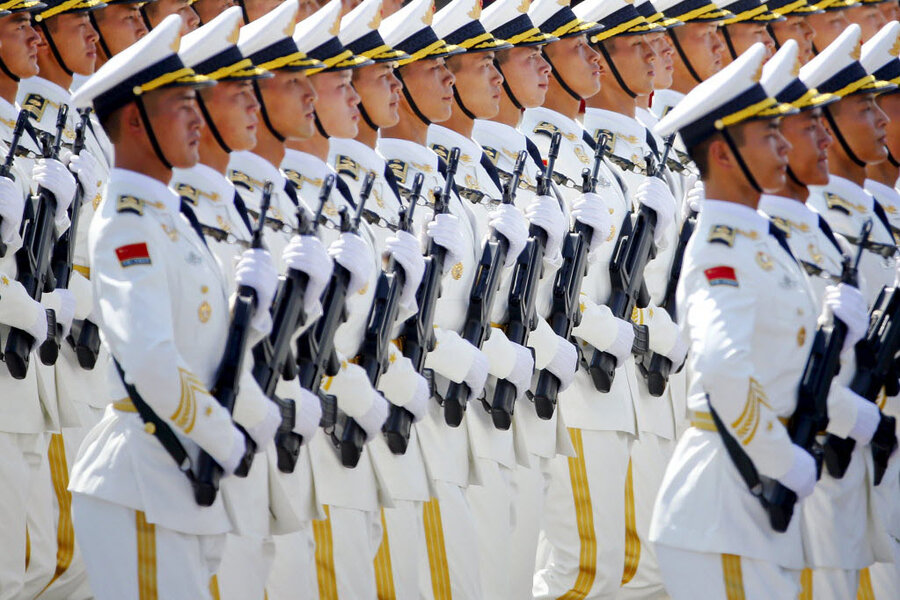Chinese ships leave the Bering Sea: Why were they there?
Loading...
Five Chinese Navy ships came within 12 miles of US territorial waters off the Alaska coast this week, an apparent first for the country’s navy that also coincided with President Obama’s visit to the state.
The Chinese presence in the Bering Sea – while fleeting, and completely legal – is being viewed as a demonstration of the country’s burgeoning naval strength and commercial interest in the Arctic region, according to military observers.
The flotilla – which included three surface combatant ships, one amphibious landing ship and a supply ship, according to various media reports – passed near the Aleutian Island chain following a joint Russian-Chinese military exercise.
The Washington Post, citing an anonymous US military official, reported Friday that the ships appear to be heading back to China. The Defense Department does not plan to provide additional updates on the flotilla, The Post reported, “indicating that defense officials likely consider the issue resolved.”
Pentagon spokesman Captain Jeff Davis commented to Reuters on Thursday: “We respect the freedom of all nations to operate military vessels in international waters in accordance with international law.”
The Chinese Defense Ministry sent the wire service a statement on Thursday that said the flotilla’s presence was “a routine arrangement as part of annual plans, and is not aimed at any set country or goal.”
Still, China watchers and military experts say there could be both military and economic motives behind China’s appearance near US waters.
“This is clearly a signal,” David Titley, a retired rear admiral who is a professor at Penn State University and an adjunct senior fellow at the Center for a New American Security, told The Post.
Exactly what it’s signaling is another question. Some believe it could be another expression of China’s growing military strength and sophistication.
The country held a parade in Beijing on Thursday featuring some 12,000 troops and a raft of new equipment, including ballistic missiles. The Christian Science Monitor reported on Thursday that the parade “is only the fourth military parade since the Mao era and is the first ever not to celebrate the founding of the People’s Republic.”
On the same day as the military parade Chinese President Xi Jinping announced plans to streamline the People’s Liberation Army by 300,00 soldiers. With 2.3 million soldiers, the PLA is the world’s largest standing army.
Mr. Xi also announced plans to modernize the Chinese military, including an emphasis on sea and air power. China has steadily increased its military spending over the past decade, and this year spent over $146 billion.
The Monitor wrote that China has been trying over the past decade to push its navy out into deeper waters:
“For years, China was known primarily for its 'brown water' Navy that stayed within Chinese coastal areas and rivers, rather than a 'blue water'oceanic navy. But that has been changing over the past decade as China has sent naval ships as far as the Mediterranean and has engaged in joint naval exercises, including with the Russian Navy in late August.”
China has also sought to become more active in the Arctic, where melting sea ice has spurred more commercial traffic and exploration for oil and natural gas. Arctic shipping routes would make it easier for Chinese companies to send products to Europe.
Russia has been heavily expanding its military presence in the Arctic, and the US is starting to do the same, The New York Times reported last week.
China’s naval interests have remained closer to home in recent years, particularly regarding their efforts to strengthen territorial claims in the South China Sea – efforts that America has often criticized.
With President Xi scheduled to visit the US for a week later this month, America’s dismissive response to this week’s activity in the Bering Sea could represent an effort to persuade China to calm tensions in its own waters, Mr. Titley told The Post.
“This is how mature super powers operate,” he said. “You don’t go to general quarters every time there’s a ship operating legally.”
This report includes material from Reuters and the Associated Press.








